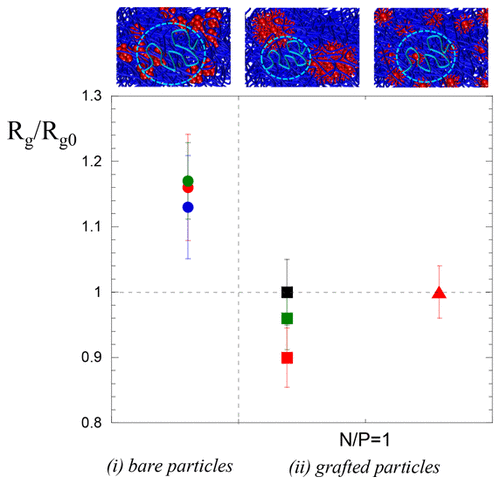当前位置:
X-MOL 学术
›
Macromolecules
›
论文详情
Our official English website, www.x-mol.net, welcomes your
feedback! (Note: you will need to create a separate account there.)
Melt Chain Conformation in Nanoparticles/Polymer Nanocomposites Elucidated by the SANS Extrapolation Method: Evidence of the Filler Contribution
Macromolecules ( IF 5.1 ) Pub Date : 2018-03-07 00:00:00 , DOI: 10.1021/acs.macromol.7b02318 Anne-Sophie Robbes 1, 2 , Fabrice Cousin 1 , Florian Meneau 2 , Jacques Jestin 1
Macromolecules ( IF 5.1 ) Pub Date : 2018-03-07 00:00:00 , DOI: 10.1021/acs.macromol.7b02318 Anne-Sophie Robbes 1, 2 , Fabrice Cousin 1 , Florian Meneau 2 , Jacques Jestin 1
Affiliation

|
We probe by SANS the conformation of polymer chains of the matrix in various nanocomposites based on the same building blocks, namely spherical magnetic nanoparticles of maghemite (γ-Fe2O3) as fillers and polystyrene (PS) for the matrix. Given that the nanoparticles can be arranged in oriented chains during the processing by an external magnetic field and/or grafted by tethered PS chains with a grafting density of ∼0.15 chains/nm2, very different organizations of the nanofillers were tested according to different particle–polymer interactions: (i) homogeneous isotropic dispersion of aggregates of bare nanoparticles; (ii) chains of bare nanoparticles oriented along one direction over the whole sample; (iii) perfect dispersion of grafted nanoparticles; (iv) homogeneous isotropic dispersion of large aggregates of grafted nanoparticles; and (v) chains of large aggregates of grafted nanoparticles objects oriented along one direction over the whole sample. Measurements were performed by the extrapolation to the zero concentration method made possible by the fact that γ-Fe2O3 has the same neutron scattering length density (SLD) as a deuterated polystyrene, so that the nanoparticles scattering is matched in a deuterated PS matrix, whether they are grafted or not. This robust method enables to check that only the polymer chain form factor is effectively probed in a very accurate way. This allows us to show some deviations of the radius of gyration induced by the nanoparticles: (i) for the case of very weak interaction between the polymer and the bare particles, the radius of gyration is swollen by 16% whatever the filler dispersion and orientation; (ii) for the athermal interaction between grafted particles and polymer, the radius of gyration is either unchanged when particles are individually dispersed or compressed of almost 11% when particles are forming overlapped clusters. Despite the remaining relatively small deviations, this is to our best knowledge the first unambiguous experimental evidence on a single system of the influence of the well-known nanofiller dispersion onto the mean chain conformation in nanocomposites for different polymer–particles interactions ranging from attractive to repulsive.
中文翻译:

SANS外推法阐明的纳米粒子/聚合物纳米复合材料的熔体链构象:填料贡献的证据
我们通过SANS探测各种纳米复合材料基体的聚合物链的基于相同的积木构象,磁赤铁矿(γ-的Fe即球形磁性纳米颗粒2 ö 3)作为基质的填料和聚苯乙烯(PS)。假设纳米颗粒可以在加工过程中通过外部磁场排列在定向链中和/或通过〜0.15链/ nm 2的接枝密度通过束缚的PS链进行接枝,根据不同的颗粒-聚合物相互作用,测试了纳米填料的非常不同的组织:(i)裸纳米粒子聚集体的均质各向同性分散;(ii)在整个样品中沿一个方向定向的裸纳米粒子链;(iii)接枝纳米粒子的完美分散;(iv)接枝纳米粒子大聚集体的均质各向同性分散;(v)在整个样品中沿一个方向定向的接枝纳米颗粒大聚集体的链。测量通过外插的事实进行到零浓度的方法成为可能的是γ-的Fe 2 ö 3具有与氘代聚苯乙烯相同的中子散射长度密度(SLD),因此无论是否接枝,纳米粒子的散射都在氘代PS基质中匹配。这种可靠的方法可以检查是否仅以非常准确的方式有效地探测了聚合物链形状因数。这使我们能够显示出纳米粒子引起的回转半径的一些偏差:(i)对于聚合物与裸露粒子之间的相互作用非常弱的情况,无论填料的分散度和方向如何,回转半径都会膨胀16%。 ; (ii)对于接枝的颗粒与聚合物之间的非热相互作用,当颗粒单独分散时,回转半径不变;当颗粒形成重叠的团簇时,回转半径几乎压缩为11%。
更新日期:2018-03-07
中文翻译:

SANS外推法阐明的纳米粒子/聚合物纳米复合材料的熔体链构象:填料贡献的证据
我们通过SANS探测各种纳米复合材料基体的聚合物链的基于相同的积木构象,磁赤铁矿(γ-的Fe即球形磁性纳米颗粒2 ö 3)作为基质的填料和聚苯乙烯(PS)。假设纳米颗粒可以在加工过程中通过外部磁场排列在定向链中和/或通过〜0.15链/ nm 2的接枝密度通过束缚的PS链进行接枝,根据不同的颗粒-聚合物相互作用,测试了纳米填料的非常不同的组织:(i)裸纳米粒子聚集体的均质各向同性分散;(ii)在整个样品中沿一个方向定向的裸纳米粒子链;(iii)接枝纳米粒子的完美分散;(iv)接枝纳米粒子大聚集体的均质各向同性分散;(v)在整个样品中沿一个方向定向的接枝纳米颗粒大聚集体的链。测量通过外插的事实进行到零浓度的方法成为可能的是γ-的Fe 2 ö 3具有与氘代聚苯乙烯相同的中子散射长度密度(SLD),因此无论是否接枝,纳米粒子的散射都在氘代PS基质中匹配。这种可靠的方法可以检查是否仅以非常准确的方式有效地探测了聚合物链形状因数。这使我们能够显示出纳米粒子引起的回转半径的一些偏差:(i)对于聚合物与裸露粒子之间的相互作用非常弱的情况,无论填料的分散度和方向如何,回转半径都会膨胀16%。 ; (ii)对于接枝的颗粒与聚合物之间的非热相互作用,当颗粒单独分散时,回转半径不变;当颗粒形成重叠的团簇时,回转半径几乎压缩为11%。











































 京公网安备 11010802027423号
京公网安备 11010802027423号